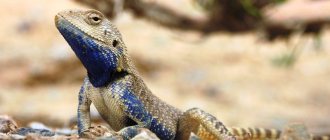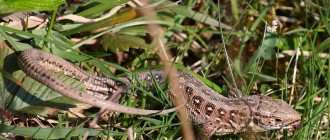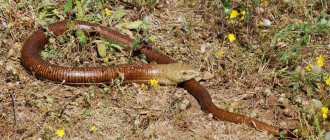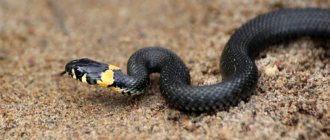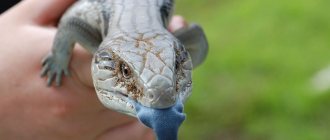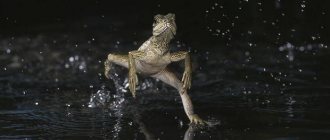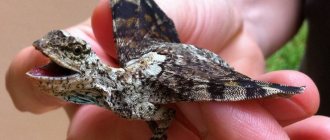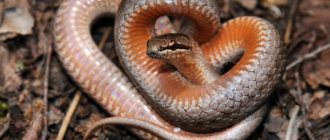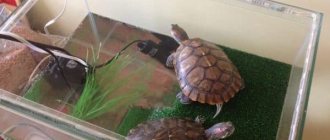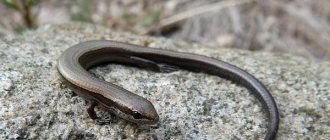The frilled lizard (Chlamydosaurus kingii) is the most striking and mysterious representative of the agamidae. At the moment of excitement, in anticipation of enemies, fleeing from danger, the frilled lizard inflates a part of the body, which owes its name. A cape or collar of a very bizarre shape resembles an open parachute. Externally, representatives of frilled lizards are similar to their prehistoric ancestors Triceratops, who lived 68 million years ago on the lands of North America.
Origin of the species and description
The frilled lizard belongs to the phylum Chordata, class Reptiles, order Squamate. Frilled lizards are the most unusual representative of the agamidae, which includes 54 genera in the family, living in the territories of South-Eastern Europe, Asia, Africa and Australia. These are butterfly dragons, spiny-tailed dragons, swallowtail dragons, Australian-New Guinea forest dragons, flying dragons, forest dragons and crested forest dragons. People have noticed that agamidae lizards resemble dragons. But in fact, the frilled lizard is very similar to prehistoric herbivorous dinosaurs.
Reptiles are the most ancient animals on earth. Their ancestors lived along bodies of water and were practically tied to them. This is explained by this. that the process of reproduction was closely connected with water. Over time, they managed to break away from the water. In the process of evolution, reptiles managed to protect themselves from dry skin and developed lungs.
The remains of the first reptiles date back to the Upper Carboniferous. The skeletons of the first lizards are more than 300 million years old. Around this time, in the process of evolution, lizards managed to replace skin respiration with pulmonary respiration. There was no longer a need to constantly moisturize the skin and the processes of keratinization of its particles began. The limbs and structure of the skull changed accordingly. Another main change is that the “fish” bone in the shoulder girdle has disappeared. In the process of evolution, more than 418 species of a wide variety of agamidae appeared. One of them is the frilled lizard.
Some lizards tear off their tail if they are surprised
As a final attempt to escape from a predator, the lizard separates its tail from its body. It usually has a bright color that attracts the attention of a predator. While the predator eats the lizard's tail, it manages to escape, and its tail will eventually grow back. This reflex can be seen in many species, including bearded dragons and geckos. This phenomenon is often observed in domestic lizards during times of severe stress.
Photo: Ansie Potgieter
Many lizards are also capable of regenerating lost limbs, meaning that if the reptile loses a leg due to conflict with a predator, the limb will grow back, as will its tail.
Appearance and features
The color of the frilled lizard's collar (Chlamydosaurus kingii) depends on its habitat. Deserts, semi-deserts, forests, and forests influenced its color. Skin color is determined by the need for camouflage. Forest frilled lizards are similar in color to old trunks of dried trees. Savannah dwellers have yellow skin and a brick-colored collar. Lizards that live at the foot of the mountains are usually deep gray in color.
The average length of Chlamydosaurus kingii is 85 centimeters, including the tail. The largest frilled lizard known to science is 100 cm. Its considerable size does not prevent representatives of the species from moving easily and quickly on four legs, running on two hind legs and climbing trees. The main attraction is the leathery collar. Usually it fits tightly to the lizard's body and is practically invisible. At the moment of excitement, in anticipation of danger, the frilled lizard inflates the part of its body, which owes its name.
A cape or collar of a very bizarre shape resembles an open parachute. The collar has a leathery structure and is penetrated by a network of blood vessels. At the moment of danger, the lizard inflates it and takes a frightening pose.
Interesting fact: The open collar makes frilled lizards look like their prehistoric ancestors, who lived 68 million years ago in North America. Like Triceratops, frilled lizards have elongated jaw bones. This is an important part of the skeleton. With the help of these bones, lizards can leave their collar open, which makes them look like prehistoric lizards with large bony crests.
The color of the collar also depends on the environment. The brightest collars are found on lizards living in subtropical savannas. They can be blue, yellow, brick and even with a blue tint.
Where does the frilled lizard live?
Photo: Frilled lizard in Australia
The frill-necked lizard lives in southern New Guinea and northern and southern Australia. In rare cases, representatives of the species are found in desert areas of Australia. How and why lizards go to the desert is unknown, because their natural habitat is in a humid climate.
Lizards of this species prefer warm and humid tropical savannas. This is an arboreal lizard that spends most of its time in the branches and roots of trees, in crevices and at the foot of mountains.
In New Guinea, these animals can be seen on fertile alluvium soils rich in nutrients. High temperatures and constant humidity create ideal conditions for lizards to live and reproduce.
Interesting fact: The frilled lizard can be seen in northern Australia. The original habitat is in the Kimberley, Cape York and Arnhem Land areas.
It is a dry wooded area, usually with open shrubs or grass. The local climate and vegetation differ from the fertile forests of the northern part of New Guinea. But native frilled lizards are well adapted to life in the hot tropics of northwestern and northern Australia. They spend most of their time on the ground among trees, often at considerable heights.
Representatives of the species in the natural environment
The homeland of these reptiles is South Guinea; in addition, individuals are also found in Australia. The suitable habitat for these creatures is forests, woodlands, and savannas overgrown with trees. Most of the time, individuals are in the trees, but they can descend in search of food. Their prey can include both reptiles and invertebrates, as well as small animals.
The frilled lizard is not too active during the hunt; it waits patiently for the intended victim to approach. During the dry period, all the inhabitants have a hard time - there is not enough food for everyone. But the frilled lizard is so patient that it climbs into the crowns of trees and waits there for up to 12 weeks. The fact is that when the lizard is in the shade of branches, it lacks warmth, and metabolic processes in its body slow down by 70%.
In open areas, representatives of the species have a huge number of enemies - lizards are hunted by cats, snakes and even birds of prey. In the process of evolution, individuals have developed a unique protective system:
- Seeing the enemy, the individual stops moving, as if becoming numb, and tries to hide so that the enemy does not notice it. If this does not work, then the lizard moves on to the next stage.
- The reptile begins to make hissing sounds, open its mouth wide, open its umbrella collar, twist its tail and stand on its hind legs. In most cases, the pursuer becomes confused and backs down from surprise.
- If such actions were unsuccessful, then the frilled lizard quickly runs away, again being in an upright position, using its hind legs and long tail to maintain balance.
As for the “cloak ,” it performs several functions in addition to protective ones. This unusual design in the form of a cervical membrane rests on the cartilaginous outgrowths of the hyoid bone - a pair on both sides. Sensing danger, the reptile spreads its cloak, which is supported by outgrowths, like an umbrella on spokes. Due to the abundance of blood vessels, the collar tissues acquire a bright red or orange color.
In addition, the “cloak” serves as a thermostat; if required, the agama uses it to catch ultraviolet rays. Males also “flaunt” this original decoration to attract the attention of females during the mating season.
The color of individuals depends on the area in which they live. For example, a species of frilled reptiles, whose habitat is the northwestern part of Australia, are colored yellowish-brown. But individuals from the south of New Guinea are darker, their color contains dark brown, black and gray shades.
Natural enemies of frilled lizards
Photo: Frilled lizard in nature
The frilled lizard has impressive dimensions. About a meter in length and with a significant weight of about a kilogram, this is a rather serious opponent. In its natural environment, the lizard has few enemies.
The most common enemies of the frilled lizard are large snakes. For the southern coast of Papua New Guinea these are the reticulated snake, green monitor, Timor monitor, green python and taipan. Frilled lizards are hunted by the New Guinea harpy, owls, Australian brown hawks, kites and eagles. Along with birds and snakes, frilled lizards are hunted by dingoes and foxes.
Natural hazards that can harm the frilled lizard include drought. This applies to the Australian habitat. Lizards of this species do not tolerate drought well. They reduce their activity, skip the mating period and are not even able to open their cloak to protect themselves from attack.
Due to its extreme habitat, the lizard's habitat is not subject to human expansion. Reptile meat is not very suitable for food, and the size of the skin of an adult is small for dressing and making accessories. That is why the frilled lizard does not suffer from human intervention.
Feeding in captivity
In the wild, Chlamydosaurus kingii feeds mainly on arthropod insects (termites, grasshoppers, caterpillars, beetles and cicadas that are caught on trees), as well as arachnids (centipedes, spiders, etc.). The lizard can also feed on small mammals if they approach at a sufficient distance.
In captivity, the diet of the frilled lizard can consist of spiders, crickets, zoobass, mealworms, small mice, and bird eggs. It is recommended to feed “live” prey, or imitate its movement using tweezers.
In addition to animal food, a small amount of plant food can be included in the lizard's diet, consisting of spinach, soft fruits and vegetables that grow in the habitats of these animals.
A prerequisite for the healthy functioning of the frilled lizard is the addition of vitamins and minerals to food, which are contained in sufficient quantities in specially developed vitamin-mineral complexes.
The feeding frequency of adult lizards is 2-3 times a week. Young animals up to six months need to be fed every day, and then up to two years old 3-4 times a week. It is necessary to add calcium during each feeding, both for adults and young animals. Vitamins can be added 1-2 times a week.
There is one peculiarity: when feeding frilled lizards, it is necessary to separate them from their relatives in order to avoid damage to the “cloak”, which rises and falls while eating, which can lead to bites. It is necessary to organize a drinking bowl with clean water for lizards, as they drink quite a lot, especially after eating.
What does the frilled lizard eat?
Photo: Frilled lizard
The frilled lizard is an omnivore, so it eats almost anything it can find. Its food preferences are determined by its habitat. The diet mainly consists of small amphibians, arthropods and vertebrates.
First of all, this is:
- Australian toads;
- tree frogs;
- narrow-mouthed;
- frogs;
- crayfish;
- crabs;
- lizards;
- small rodents;
- ants;
- spiders;
- beetles;
- ants;
- termites.
The frilled lizard spends most of its life in trees, but sometimes descends to feed on ants and small lizards. Its menu includes spiders, cicadas, termites and small mammals. The frilled lizard is a good hunter. Tracks down food like a predator from ambush, using the element of surprise. She hunts not only insects, but also small reptiles.
Like many lizards, Chlamydosaurus kingii is a carnivore. They tend to prey on those who are smaller and weaker. These are voles, forest rodents, and rats. Lizards love to eat butterflies, dragonflies and their larvae. Tropical forests are full of ants, mosquitoes, beetles and spiders, which also diversify the menu of frilled lizards. The rainy season is especially favorable for lizards. At this time they eat off. They eat several hundred flying insects per day.
Interesting fact: Lizards are not averse to dining on crabs and other small crustaceans that remain in the coastline area after high tide. Frilled lizards find mollusks, fish, and sometimes larger prey on the shore: octopuses, starfish, squid.
Maintenance and care
For normal maintenance you need a spacious, well-equipped terrarium with a large bottom area. Unlike other lizards, frilled lizards spend their entire lives in trees, not on the ground, and need space.
For a lizard, you need a terrarium at least 130-150 cm long, and high, from 100 cm. It is better to cover all windows, except the front one, with opaque material, this way you will reduce stress and increase the sense of security.
They have good eyesight and are sensitive to movement in the room, plus the limited vision will help them concentrate on the food while feeding. By the way, if the lizard is stressed or has recently appeared, then try closing the front window, it will come to its senses faster. It is better that the length of the terrarium is 150 cm, the height is from 120 to 180 cm, especially if you keep a pair. If it is one individual, then a little smaller, then all the same, height is very important. It makes them feel safe, plus they climb in to warm themselves.
Branches and various snags should be located at different angles, creating a structure similar to scaffolding.
Lighting and temperature
For maintenance you need to use a UV lamp and a lamp for heating reptiles. The heating zone should be at a temperature of 40-46°C, directed towards the upper branches.
But, do not try to place the llamas too close to the branches, as the lizards can easily get burned.
The distance between the lamp and the heating zone is at least 30 cm. And in the rest of the area the temperature is from 29 to 32°C. At night it can drop to 24°C.
Daylight hours are 10-12 hours.
Feeding
The basis for feeding the frilled lizard should be a mixture of different insects: crickets, grasshoppers, locusts, worms, zoobass. All insects should be dusted with reptile food containing vitamin D3 and calcium.
You can also give baby mice, depending on the size of the lizard. Juveniles are fed insects, but small ones, daily, two or three times a day. You can also sprinkle them with water, reducing playfulness and replenishing the lizard’s water reserves.
They also eat fruits, but you need to try, since much depends on the individual; some refuse greens.
Adults are fed once a day or two days, again with the addition of calcium and vitamins. Pregnant females are fed more frequently and supplements are given at each feeding.
Ways to remove lizards from your property
If for some reason you decide to get rid of uninvited guests, then you can act in the following ways:
p, blockquote 23,0,0,0,0 —>
- Get cats. Representatives of the cat family are the real enemies of lizards. Cats will very quickly catch lizards and rid you of the presence of unpleasant animals. However, this method has one significant drawback - cats can crap in the beds and lie on seedlings or flower beds. You will have to monitor their behavior.
- You will notice that lizards most often appear in the area where insects live. For example, if your cabbage is infested with pests, then reptiles will constantly lurk around it. It is enough to eliminate the main source of food, and cold-blooded representatives of the animal world will leave your area. Most gardeners use insecticides to get rid of various pests; they can also poison populations of cold-blooded insects. Because of this, large families rarely live on the plots. Most often, you can notice 2-3 representatives that do not cause much harm.
- If you have an area near a forest and there are a lot of lizards on it, then it’s a good idea to use a pepper solution. It is suitable for those who do not want to use insecticides so as not to spoil the harvest. To prepare the solution, you need to dissolve 3 heaped tablespoons of pepper seasoning in 10 liters of water. Take black hot or red hot pepper. Before spraying, you need to find places where reptiles live, for example, a vegetable garden, planting fruit trees or shrubs.
It is worth fighting reptiles only in cases where they encroach on your country house or interfere with your normal use of the site. In all other cases, it is not recommended to treat the area, since the benefits of lizards significantly outweigh the possible harm from their vital activity.
p, blockquote 24,0,0,0,0 —>
p, blockquote 25,0,0,0,0 —>
You can often find a lizard at your summer cottage; many people take this calmly, but many are wary, believing that this small creature will spoil the harvest. How to treat these creatures, are lizards harmful in the countryside, is it worth getting rid of them, or, on the contrary, attracting them to your plot.
p, blockquote 27,0,0,0,0 —>
The benefits and harms of lizards in the country
First of all, it should be said that there is no harm from lizards; they are completely safe for your crops and for humans as well. Of course, dangerous lizards exist, but they are found in the distant tropics. There is no need to be afraid that they will sneak into your house and make a warm nest there; lizards live in burrows underground, and they are not at all interested in your home. The worst thing these reptiles can do if they are caught by a person is to “spray” you with their droppings, this is the only way they can protect themselves from people.
p, blockquote 28,0,0,0,0 —>
But the benefits of lizards in the country are very significant, because they destroy insects that can cause significant damage to your harvest. The main prey of lizards are mole crickets, and they are known to deprive plants of roots, as a result of which the plant dies. Lizards also love to feast on snails, the main pests of cabbage. Reptiles also feed on all kinds of beetles and their larvae, and they are able to find such pests without much difficulty even in the most hidden places. Grasshoppers, centipedes, spiders, ticks, bedbugs, flies and other living creatures harmful to the garden can become breakfast, lunch and dinner for lizards.
p, blockquote 29,0,0,0,0 —>
Speaking about other benefits of lizards in the country, it should be said that they prevent the development of plant diseases that can be caused by fallen berries rotting on the ground. The fact is that a berry that falls to the ground will not have time to rot and infect the plant with any infection, because the lizard will immediately “clean up” the ground from the fallen berries.
p, blockquote 30,0,0,0,0 —>
p, blockquote 31,0,0,0,0 —>
The need to write a reference may appear completely unexpectedly - work colleagues or law enforcement officers may ask for it. This article will tell you how to write a description correctly.
p, blockquote 33,0,0,1,0 —>
Buying your own apartment is a serious step that requires making informed decisions. Accommodation that has been chosen hastily may no longer suit you after a while, and it is unlikely that it will be possible to change it quickly. What aspects should you pay attention to when buying an apartment is the topic of this article.
p, blockquote 34,0,0,0,0 —>
p, blockquote 35,0,0,0,0 —>
For any computer, one of the most important devices is the screen. There are several recommendations based on which you can choose the ideal monitor for your home. What you need to pay attention to when choosing a monitor is the topic of our article.
Water
In nature, frilled lizards thrive during the rainy season, which keeps them hydrated. In captivity, the humidity in the terrarium should be about 70%. The terrarium should be sprayed with a spray bottle daily, and for juveniles three times a day, during feeding. If funds allow, it is better to install a special system that maintains air humidity.
Thirsty lizards collect drops of water from the decor, but they will ignore the water container in the corner. Unless it helps maintain humidity through evaporation. They usually collect droplets a few minutes after you spray the terrarium.
The first sign of dehydration is sunken eyes, followed by skin condition. If you pinch it and the fold does not smooth out, then the lizard is dehydrated. Spray the terrarium generously and observe her behavior, or immediately go to the veterinarian for subcutaneous injections of liquid.
Basilisks can run on water!
Photo: www.wonderopolis.org
The basilisk has a rather unique quality - it can run on the surface of water! For this unique ability, the basilisk was nicknamed “the lizard of Jesus Christ.” Reptiles are helped to run on water by a scaly border (a kind of membrane) on their hind legs. When a basilisk runs away from a predator, it makes frequent strikes on the water with its hind legs, as a result, the top layer of water does not have time to break through the membranes. When running through water, the basilisk is in contact with water for only 0.068 seconds!
Appeal
They feel comfortable in the terrarium and uncomfortable outside it. Do not touch the lizards again if you see that they are feeling unwell outside their usual environment. The most important thing is that she is healthy and active, even if this means you only have to watch her and not hold her in your hands.
A frightened frilled lizard opens its mouth, hisses, puffs up its hood, and may even bite you. It looks impressive, but keep in mind that it does not have the best effect on her condition.
Damage from lizards: is there any?
The only negative quality of reptiles is that they attract moles to the area. They will dig up your entire garden in search of lizards, build traps for them and spoil the harvest. For this reason, many still try to get rid of cold-blooded animals so as not to expose their area to danger.
p, blockquote 21,0,0,0,0 —>
The disadvantage of these animals is that they reproduce quickly. If there are too many lizards in the yard, they can crawl into the house, but they do this extremely rarely. It is unpleasant that a reptile will restore order in your home. For this reason, they also try to get rid of them. Although in most cases they live in burrows, and in the summer they spend most of the day in the sun. In winter they usually burrow into the ground.
p, blockquote 22,1,0,0,0 —>
Reproduction
For these lizards, the breeding season begins with the arrival of the warm, wet season. In nature, females begin to reproduce at the age of about two years, and males at one year. Mating is preceded by mating games, during which the male tries to attract the female with special head movements, similar to nods.
After mating, the female lays 8 to 14 eggs in wet sand. The incubation period lasts for about ten weeks, after which offspring are born.
INTERESTING FACTS
- The frilled lizard is often kept as a pet. In captivity, she raises her collar only in exceptional cases.
- A remarkable feature of this lizard is its ability to run on its hind legs, holding its body almost vertically raised above the ground. She maintains balance while running with the help of her tail.
- Along the edges of the lizard's jaw strong teeth grow, similar to those of humans: molars, canines and incisors.
- Another lizard that lives in trees in Australia is the Gulde's monitor lizard. The Aborigines believe that the wounds from its bites do not heal.
- Frilled lizard, depicted on the Australian two-cent coin. The lizard is also called the “dragon lizard.”
SELF-DEFENSE MECHANISMS OF THE FRILLED LIZARD
The collar is covered with large scales, the edges are jagged. The color of the collar changes depending on the habitat of the lizard.
In case of danger, the collar opens like an umbrella. This movement is accompanied by the opening of a wide mouth and striking of the tail on the ground.
BEARDED AGAMA: CARE AND MAINTENANCE AT HOME
CAPE MONITOR: MAINTENANCE AND CARE AT HOME, PHOTO
MAISE SNEAKER: MAINTENANCE AND CARE AT HOME, PHOTO
LIFESTYLE
Like most other lizards, the frilled lizard is active during the day. The sun, heating its blood, transfers energy that the lizard spends searching for food. The hard scales covering its body protect against fluid loss. She lives in trees, where she often lies on branches and basks in the sun.
This lizard moves equally well both in trees and on the surface of the ground. She can run on both two and four limbs. When the frilled lizard runs along the ground on its hind legs, it holds its body almost vertically raised above the ground. The front legs hang down freely, and the raised tail makes oscillatory movements and helps maintain balance. Paleontologists believe that some ancient reptiles, such as dinosaurs, moved in this way.
The lizard's body is pink or dark gray on top with dark transverse stripes on the back and tail. The collar of this lizard is a thin leather membrane covered with scales. On each side it is supported by two long cartilaginous outgrowths of the hyoid bone. In case of impending danger, the lizard opens its collar like an umbrella. At the same time, her mouth opens, and the more it opens, the wider the umbrella collar unfolds. The lizard itself sits on its hind legs, raising the front part of its body high. If the enemy does not retreat, the frilled lizard goes on the attack: it bites hard and strikes with its long tail. It is believed that the collar of this lizard also functions as a solar heat collector and traps the sun's rays.
